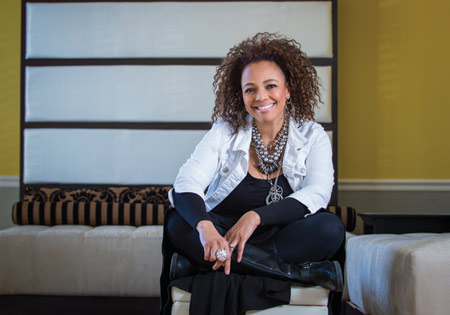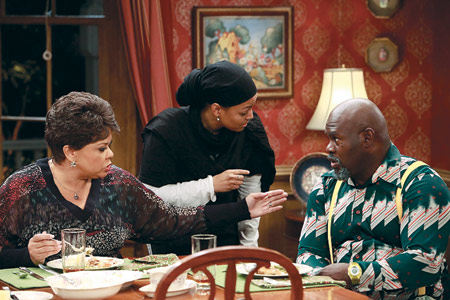By Amy Dawes
 Director Kim Fields
Director Kim Fields When she broke into directing by doing teen sitcoms and children’s programs at Nickelodeon in the late ’90s, Kim Fields had something extra to bring to the table. She had been a young TV performer herself, co-starring from age 10 to 18 as one of four girls at the center of the long-running NBC sitcom The Facts of Life.
“I could relate on so many levels to those young actors because I had lived through what they were currently living,” says Fields. “I understood how you have to shift your focus on a dime. One minute you’re taking a geometry test in studio school; the next minute you’re on the set having to know your lines and hit your marks. I wasn’t so far ahead of them age-wise that I couldn’t connect.”
Dating back to her days on The Facts of Life in the ’80s, Fields was always the curious kid who would climb onto the camera pedestal between takes to question the operators about how to frame a shot. “I was a crew baby. When I wasn’t in studio school, I loved talking to the directors, the lighting guys, the second unit,” she recalls. And even in her youth, says Fields, she was keenly aware of the downward trajectory that can curse child actors who find the spotlight early. “I was always thinking, ‘What’s the next gig?’ I knew I had to have a backup plan. I didn’t want to be a has-been at age 18.”
Fields traces her creative roots to her upbringing in Harlem by her mother and grandmother, and then her work as a child actor in L.A., before landing on The Facts of Life. From the show’s directors; John Bowab, Asaad Kelada, Ellen Gittelsohn (nee Falcon); and their teams, young Kim began to learn the craft. “They were the most wonderful half-hour directors and they taught me so much of what I know about multi-cam and what I do now,” she says.
When The Facts of Life ended, Fields studied TV and film at Pepperdine University, but the path to directing didn’t open up until she formed an alliance with two young performers who, like herself, were facing a perplexing transition: Malcolm-Jamal Warner, who’d played Theo Huxtable on The Cosby Show, and Blair Underwood, coming off his stint on L.A. Law. “We were TV actors dying to get into film,” says Fields, “and Blair always said, ‘iron sharpens iron.’ We were always trading ideas and inspiring each other. It comes down to ‘you get what you give.’”
 DINNER TIME: Despite the incredibly fast pace of directing Meet the Browns, Fields says there is still room to be creative and flourish as a director.
DINNER TIME: Despite the incredibly fast pace of directing Meet the Browns, Fields says there is still room to be creative and flourish as a director. The trio used their combined experience and connections to get short film projects off the ground and landed work directing music videos. Fields made a dramatic short, Silent Bomb (1994), about a policewoman whose life is turned upside down after she contracts HIV from a blood transfusion. But when paying work came knocking in the late ’90s, it was in the form of youth-oriented programming. Nickelodeon Studios was hitting its stride with scripted series like Kenan & Kel and Taina, and Fields’ on-camera experience with multi-cam sitcoms made her a great fit to direct. “I had a tremendous base of knowledge to draw on, whether it was to do with a technical component or a creative one,” she says. She continued to direct when her acting career resumed and during a five-year run on the urban comedy Living Single with Queen Latifah, she directed several episodes.
Then in 2009, Fields got a fateful invitation: director-producer and all-around media mogul Tyler Perry wanted her to join the team making sitcoms for TBS at his Atlanta-based studios. Fields, who with her husband, actor Christopher Morgan, has a 5-year-old son, found the steady work on Perry’s House of Payne and Meet the Browns appealing. “We thought it would be temporary, that we’d stay a few months and go back to New York or L.A.,” she says. As it turns out, she clicked with Perry’s fast-paced production style; something not everyone can manage.
“We film an episode a day, and as a director, you’re assigned three or four episodes each week,” says Fields. “It’s definitely a system, but it works. If you’re able to grasp that, and be effective so that no one feels any balls are dropped when Tyler isn’t there in the director’s chair, then it’s considered a job well done.” The characters and material, written, produced and directed by Perry, typically evolve from stage productions to movies to television, often with the same actors in the roles. “By the time we come in as TV directors, you have a great crew, and actors who are so focused and so on it,” says Fields. “It’s not like reinventing the wheel; it’s more like minding the store, but you’re still able to be creative and flourish as a director within that.”
Setups are done in classic multi-cam proscenium style involving a main set and various swing sets. “It’s a well-oiled machine. It requires a lot of prep and planning, but you still have your rehearsal time and your time to be creative,” says Fields.
Despite her background, Fields does not want to be known as a director who focuses primarily on actors. “I never want anyone to call me an actor’s director,” says Fields, “because I never want my crew to feel like ‘that’s nice, but what about us?’ To me, it’s just as important to understand why a lighting director decides to go with a certain kind of gel, or why [they’d use] a tungsten instead of a 10K. Nothing on a set is accidental, and it’s a gift to be on a team where people want to share their talents with you. What I try to do is foster an environment where people want to bring their A-game to the table all the time.”
While many of her opportunities have been on shows aimed at black audiences, she says, “I come from the mindset of letting my work and my reputation as a professional speak for itself, rather than my race or my gender. I’m fully aware that I stand on the shoulders of female directors like Gittelsohn, Debbie Allen and Ida Lupino, but I don’t pitch myself that way; I’m just a director.”